Haryana State Board HBSE 8th Class Maths Solutions Chapter 3 Understanding Quadrilaterals Ex 3.1 Textbook Exercise Questions and Answers.
Haryana Board 8th Class Maths Solutions Chapter 3 Understanding Quadrilaterals Exercise 3.1
Question 1.
Given here are some figures.
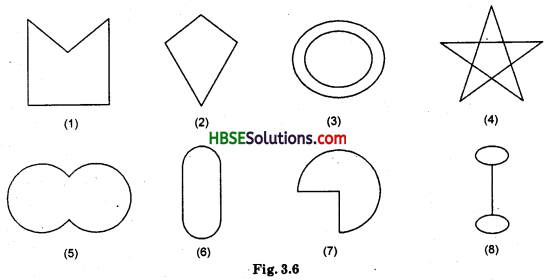
Classify each of them on the basis of the following:
(a) Simple curve
(b) Simple closed curve
(c) Polygon
(d) Convex polygon
(e) Concave polygon.
Solution:
(a) Simple curve : 1, 2, 5, 6, 7
(b) Simple closed curve : 1, 2, 5, 6, 7
(c) Polygon : 1, 2, 4
(d) Convex polygon: 2
(e) Concave polygon: 1, 4.
Question 2.
How many diagonals does each of the following have ?
(a) A convex quadrilateral.
(b) A regular hexagon.
(c) A triangle.
Solution:
(a) A convex quadrilateral has two diagonals.
(b) A regular hexagon has 9 diagonals.
(c) A triangle has no diagonal.
![]()
Question 3.
What is the sum of the measures of the angles of a convex quadrilateral ? Will this property hold if the quadrilateral is not convex ? (Make a non-convex quadrilateral and try !).

Solution:
ABCD is a convex polygon.
JoinBD.
In △ABD, ∠A + ∠ABD + ∠ADB =180°…(i)
[Triangle sum property]
In △BDC,
∠DBC + ∠BDC + ∠BCD =180° ……(ii)
Adding (i) and (ii),
∠A + (∠ABD + ∠DBC) + (∠ADB + ∠BDC) + ∠BCD = 360°
∴ ∠A + ∠ABC + ∠ADC + ∠BCD = 360°
Yes, this property hold if the quadrilateral is not convex.
Question 4.
Examine the table. (Each figure is divided into triangles and the sum of the angles deduced from that).

What can you say about the angle sum of a convex polygon with number of sides ?
(a) 7,
(b) 8,
(c) 10,
(d) n.
Solution:
(a) Sum of angles = (7 – 2) × 180° = 900°.
(b) Sum of angles = (8 – 2) × 180° = 1080°.
(c) Sum of angles = (10 – 2) × 180° = 1440°.
(d) Sum of angles = (n – 2) × 180° = 180 (n- 2).
![]()
Question 5.
What is a regular polygon ? State the name of a regular polygon of
(i) 3 sides,
(ii) 4 sides,
(iii) 6 sides.
Solution:
A regular polygon is both ‘equiangular’ and ‘equilateral’. For example, a square has sides of equal length and angles of equal measure. Hence it is a regular polygon.
(i) equilateral triangle,
(ii) square,
(iii) regular hexagon.
Question 6.
Find the angle measure x in the following figures :
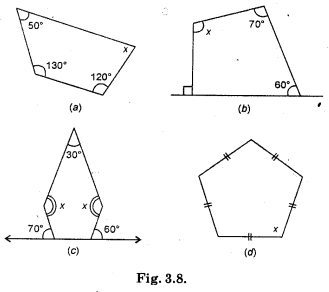
Solution:
(a) ∠x + 50° + 130° + 120°
= 360°
or ∠x + 300° = 360°
∴ ∠x = 360° – 300°
= 60°
∴ ∠x = 60°
[∵ Sum of angles of a quad, is 360°)
(b) ∠DAX = 90°
∠DAX + ∠DAB = 180° [Linear pair]
90° + ∠DAB = 180°
∴ ∠DAB = 180° – 90°
= 90°
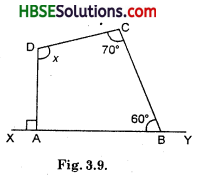
In quad. ABCD,
∠A + ∠B + ∠C + ∠D = 360°
90° + 60° + 70° + ∠x = 360°
or 220° + ∠x = 360°
∴ ∠x = 360° – 220°
= 140°
∴ ∠x = 140°.
(c) ∠EAP + ∠EAB = 180° [Linear pair]
70° + ∠EAB = 180°
∴ or ∠EAB = 180° – 70°
∴ ∠EAB = 110°
∠CBQ + ∠CBA = 180°
60° + ∠CBA = 180°
∴ ∠CBA = 180° – 60°
∴ ∠CBA = 120°
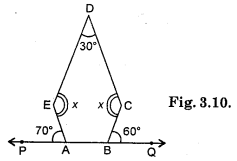
In pentagon ABCDE
∠A + ∠B + ∠C + ∠D + ∠E = 540°
110° + 120° + x + 30° + x = 540°
260° + 2x = 540°
or 2x = 540° – 260°
or 2x = 280°
∴ x = 140°.
(d) ∠x + ∠x + ∠x + ∠x + ∠x = 540°
[∵ Given pentagon is regular]
5∠x = 540°
∠x = \(\frac{540}{5}\) = 108°
∴ ∠x = 108°
![]()
Question 7.
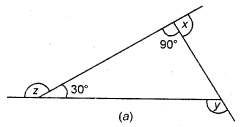
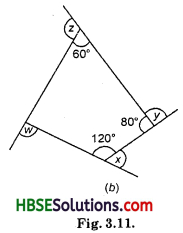
(a) Find x + y + z,
(b) Find x + y + z + w.
Solution:
(a) ∠z + ∠ABC = 180°
[Linear pair]
∴∠z + 30° = 180°
∴ ∠z = 180° – 30°
= 150°
∴ ∠z = 150°
In △ABC, ∠A + ∠B + ∠C = 180°
90° + 30° + ∠C = 180°
or 120° + ∠C = 180°
∴ ∠C = 180° – 120°
= 60°
Again, ∠BAC + ∠x = 180
[Linear pair]
or 90° = ∠x = 180°
∴ ∠x = 180° – 90°
= 90°
∴ ∠x = 90°
∠ACB + ∠y = 180°
or 60° + ∠y = 180°
∴ ∠y = 180° – 60°
= 120°
∴ ∠y = 120°
∴ ∠x = 90°
∠y = 120°
∠c = 60°.
(b) In ABCD,
∠A + ∠B + ∠C + ∠D = 360°
or 60° + ∠B + 120° + 80° = 360°
or 260° + ∠B = 360°
or ∠B = 360° – 260°
= 100°
∴ ∠B = 100°
Now, ∠A + 120° = 180°
or ∠A = 180° – 120°
= 60°
∴ ∠A = 60°
∴ ∠x = 60°
∠y + 80° = 180°
or ∠y = 180° – 80°
= 100°
∴ ∠y = 100
∠z + 90° = 180°
or ∠z = 180° – 90° = 90°
∴ ∠z = 90°
∠w + 100° = 180°
or ∠w = 180° – 100°
∴ ∠w = 80°
∴ ∠x = 60°
∠y = 100°
∠z = 90°
∠w = 80°